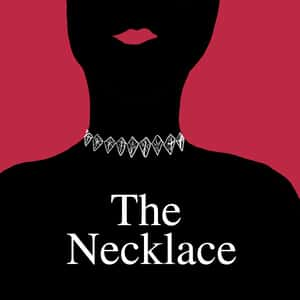The Necklace Themes
The main themes in "The Necklace" are greed, deceptive appearances, and beauty and vanity.
- Greed: Mathilde Loisel's overwhelming desire to live a life of luxury blinds her to the comforts she already possesses and ultimately leads to her losing what wealth and status she initially has.
- Deceptive appearances: Mathilde is preoccupied with the appearance of wealth and spends years working to replace a necklace that is eventually revealed to have been a fake.
- Beauty and vanity: While Mathilde's beauty allows her a fleeting moment of social success at the ball, she has lost both beauty and vanity by the end of the story.
Themes
Greed
Mathilde’s desire to live a lifestyle beyond her financial means at first makes her a jaded woman, unable to appreciate her relative comforts. Early in the story, she has the financial means to employ household servants, she isn’t required to work herself, and she enjoys a comfortable lifestyle. Even with her abundance, particularly compared to her social standing at the story’s end, she is filled with greed, “tortured” and “angry” that she lacks the luxuries other women enjoy. This anger spills over onto her husband, who is elated when he believes that an invitation to a ball will relieve his wife’s feelings of bitter discontent. Yet Mathilde’s greed overshadows even this moment, and she refuses the invitation because her clothing leaves her poorly “equipped” for such an event. When her husband sacrifices his savings to purchase the dress of her dreams, Mathilde does not even offer her thanks for his kind gesture. Moreover, when the date of the ball has nearly arrived, Mathilde again professes that she can’t attend, even with her expensive dress, because she doesn’t have the jewels to pair with the dress and believes that she therefore “shall look like distress.” After taking her husband’s suggestion to borrow some jewelry from her friend Madame Forestier, Mathilde cannot be satisfied with the initial pieces of jewelry she is shown, longing for something more stunning and even more expensive. Mathilde constantly evaluates her own wealth in comparison to those who have more than she does. She never considers the comforts and luxuries she is able to enjoy, particularly before the ball, compared to those in the lower classes. Mathilde is therefore blinded by greed, always angry at her position in life, feeling that she deserves more and that she simply hasn’t been dealt a fair hand. Her lack of appreciation for her economic standing early in the story eventually robs her of both her comforts and her beauty.
Deceptive Appearances
Mathilde spends her years of beauty longing for a lifestyle of extravagance. When she is presented with true gems at Madame Forestier’s, including a pearl necklace and “precious stones of admirable workmanship,” Mathilde dismisses them because she believes they are unable to fully represent her sense of self-worth. Ironically, she chooses a “superb necklace of diamonds” which fulfills her definition of exquisite beauty because she believes it to be the most expensive and elegant choice. She is so thrilled with her decision that she is “lost in ecstasy” when she beholds it around her neck. This necklace which fulfills Mathilde’s sense of beauty and lavish projections is, however, a fake. The diamonds aren’t real, yet Mathilde believes that they are. Mathilde has based her entire sense of self-worth on ideals of wealth and status, yet in the decision which completely changes the trajectory of her life, she proves unable to distinguish between true treasures and worthless replicas. Mathilde’s own personality is much the same. On the dance floor, she triumphs, feeling herself fully alive only because she believes the dress and jewelry she wears make her beautiful. Yet it is all a façade. Mathilde is indeed an attractive woman; the opening sentence notes that “she was one of those pretty and charming girls.” She doesn’t need an expensive dress or elegant jewelry to make her beautiful, but she is blind to this truth. Mathilde’s predilection for a flashy and lavish lifestyle ends with her great deception, as she is unable to ultimately gauge the true worth of the very things she admires most.
Beauty and Vanity
Early in the story, it is noted that “with women there is neither caste nor rank; and beauty, grace, and charm act instead of family and birth.” It could therefore be expected that Mathilde’s beauty puts her in the position of being able to transform her life, even without a dowry or “means of being known.” Yet it is noted that she “let herself” be married to her husband, a passive action that connotes a type of weakness despite her great beauty. Mathilde’s moment to shine finally arrives at the ball, and she relishes this opportunity to showcase her social graces and stunning beauty. She is “prettier than them all,” captivating the entire room of men, and this makes her “crazy with joy.” This moment, the pinnacle of all Mathilde has dreamed of, is short-lived. Instead of entering a higher social realm through her attendance at the ball, Mathilde is forever shut out of this wealthy sphere because of her decision to focus her efforts on her physical beauty. In losing the necklace, Mathilde is thrust into a different lifestyle which robs her of the beauty she had once hoped would be her salvation from a mundane life. Mathilde’s outer beauty brings her a fleeting moment of social success, but it doesn’t prove capable of altering her social status or happiness. If Mathilde had proven herself less self-focused, her vanity may not have brought her to both monetary and physical ruin.
See eNotes Ad-Free
Start your 48-hour free trial to get access to more than 30,000 additional guides and more than 350,000 Homework Help questions answered by our experts.
Already a member? Log in here.
